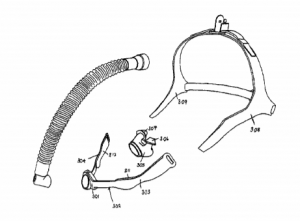 On Friday, October 5th, the U.S. International Trade Commission (ITC) issued a notice of institution of a Section 337 patent infringement investigation requested by New Zealand-based appliance manufacturer Fisher & Paykel against San Diego, CA-based medical equipment firm ResMed. The ITC instituted the Section 337 investigation after Fisher & Paykel alleged that certain sleep apnea products imported for sale by ResMed infringe upon U.S. patents held by the New Zealand firm.
On Friday, October 5th, the U.S. International Trade Commission (ITC) issued a notice of institution of a Section 337 patent infringement investigation requested by New Zealand-based appliance manufacturer Fisher & Paykel against San Diego, CA-based medical equipment firm ResMed. The ITC instituted the Section 337 investigation after Fisher & Paykel alleged that certain sleep apnea products imported for sale by ResMed infringe upon U.S. patents held by the New Zealand firm.
There are five patents-at-issue in this investigation, including:
- U.S. Patent No. 9333315, titled Breathing Assistance Apparatus. It covers a mask assembly for delivering positive airway pressure to a user that involves the use of a nasal cannula, a thin tube inserted into the nasal cavity, having at least one flared end prong to create a seal in the user’s nare, or nostril.
- U.S. Patent No. 9517317, same title as the ‘315 patent. It claims a mask assembly for delivering breathing gases to a user with the use of headgear comprised of a continuous and substantially curved elongate member and two headgear straps attaching to the member’s end.
- U.S. Patent No. 9539405, same title. It claims a mask assembly with a nasal cannula prong part and a nasal cannula body part for delivering positive airway pressure to a user, the prongs having angled ends to direct gases to the nasal passages and the bodies having a ball joint connector allowing it to partially swivel.
- U.S. Patent No. 9907925, titled Nasal Pillows for a Patient Interface. It covers a nasal pillow member for use with an apparatus for providing a stream of gases to a user in a way that minimizes contact between a pillow gasket and the user’s upper lip.
- U.S. Patent No. 9974914, same title as the ‘315 patent. It claims a nasal cannula configured to deliver humidified gases to a user, the cannula being comprised of an active humidifier, a heated transport conduit and a cannula designed to fit in the nasal cavity.
 Fisher & Paykel first filed a complaint for a Section 337 investigation with the ITC in early September, alleging that certain obstructive sleep apnea treatment masks and components infringing upon the asserted patents were being imported into the U.S. by ResMed. As the complaint notes, obstructive sleep apnea (OSA) is a sleep disorder affecting about 9 percent of the U.S. population; the condition causes muscles that usually hold open a person’s airway open to relax and collapse, sealing the airway.
Fisher & Paykel first filed a complaint for a Section 337 investigation with the ITC in early September, alleging that certain obstructive sleep apnea treatment masks and components infringing upon the asserted patents were being imported into the U.S. by ResMed. As the complaint notes, obstructive sleep apnea (OSA) is a sleep disorder affecting about 9 percent of the U.S. population; the condition causes muscles that usually hold open a person’s airway open to relax and collapse, sealing the airway.
OSA can be treated with the use of medical devices which implement a technique known as continuous positive airway pressure (CPAP). CPAP devices involve a gas supply with a conduit that supplies pressurized gas to a patient through an air delivery hose connected to a patient’s mouth and/or nose. The pressurized gas acts as a pneumatic splint for the airway, keeping the airway open during sleep and eliminating the OSA sleep pattern that can result in daytime drowsiness and irritability caused by a lack of continuous sleep.
Fisher & Paykel practice elements of the asserted patents-in-suit in the company’s Healthcare Opus 360 CPAP mask system. The company’s ITC complaint includes non-technical descriptions of the asserted patents identifying the aspects of CPAP mask systems that are covered by the patents. For example, the interconnectivity of the components and shape of the mask system covered by the ‘315 patent improves the comfort of patients and makes the mask easier to use. Mask system elements covered by the other asserted patents are also designed to improve patient comfort. Fisher & Paykel allege that ResMed’s sale of sleep apnea treatment products including the AirFit P10, AirFit P10 for Her and AirFit P10 for AirMini infringe upon the patents asserted in the Section 337 complaint; the New Zealand firm also notes that further discovery may uncover additional infringing mask systems.

![[IPWatchdog Logo]](https://ipwatchdog.com/wp-content/themes/IPWatchdog%20-%202023/assets/images/temp/logo-small@2x.png)

![[Advertisement]](https://ipwatchdog.com/wp-content/uploads/2024/04/Patent-Litigation-Masters-2024-sidebar-early-bird-ends-Apr-21-last-chance-700x500-1.jpg)

![[Advertisement]](https://ipwatchdog.com/wp-content/uploads/2021/12/WEBINAR-336-x-280-px.png)
![[Advertisement]](https://ipwatchdog.com/wp-content/uploads/2021/12/2021-Patent-Practice-on-Demand-recorded-Feb-2021-336-x-280.jpg)
![[Advertisement]](https://ipwatchdog.com/wp-content/uploads/2021/12/Ad-4-The-Invent-Patent-System™.png)







Join the Discussion
No comments yet.